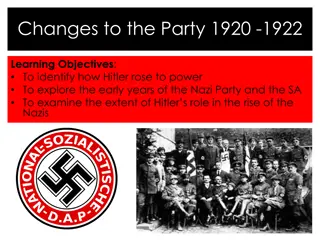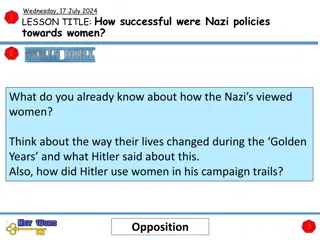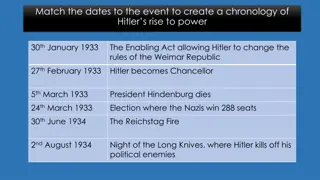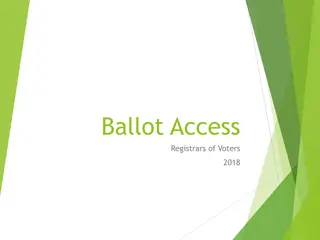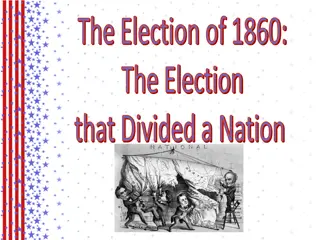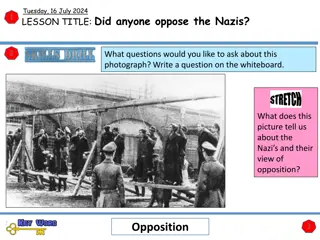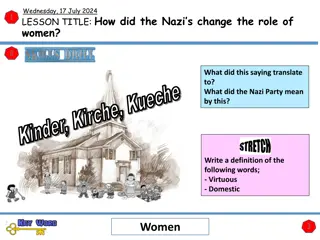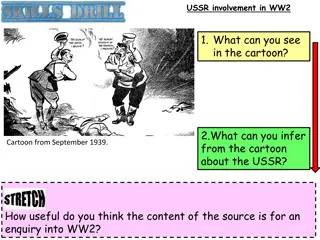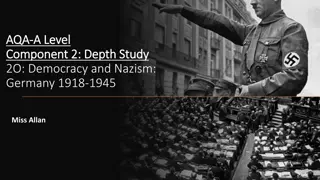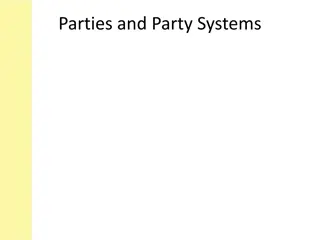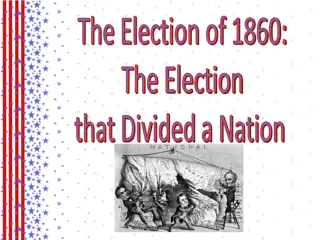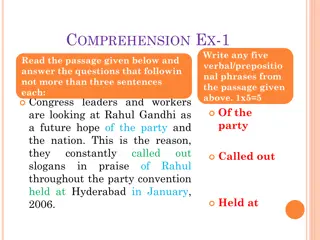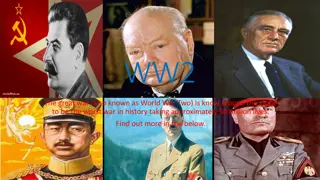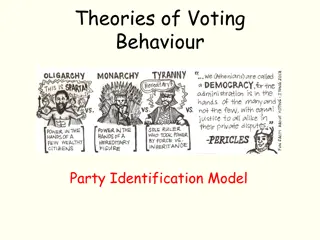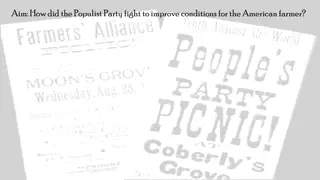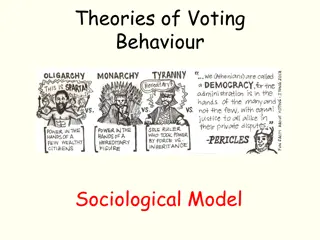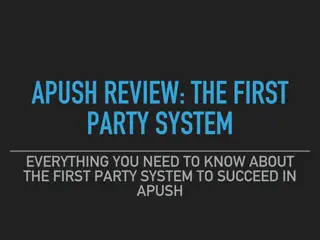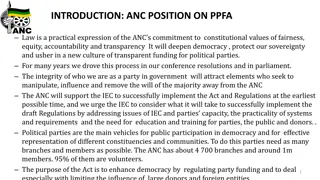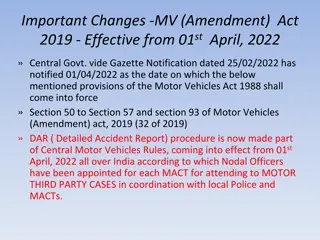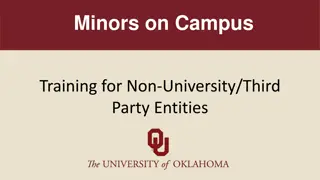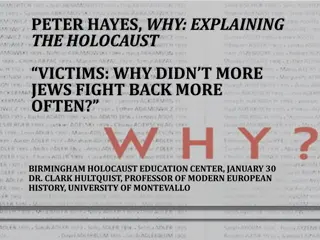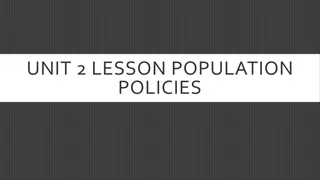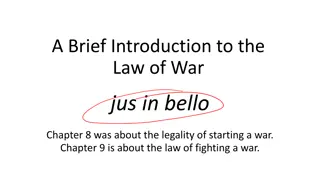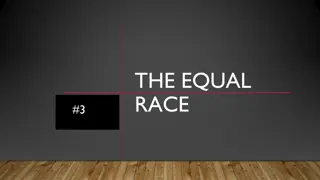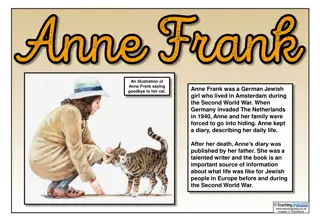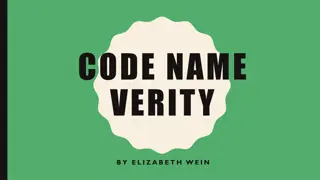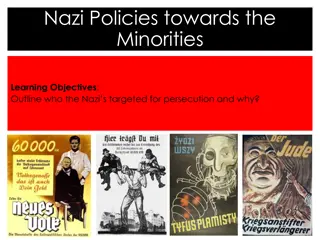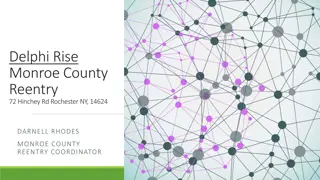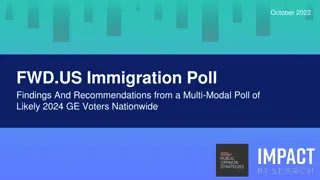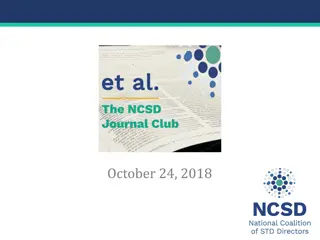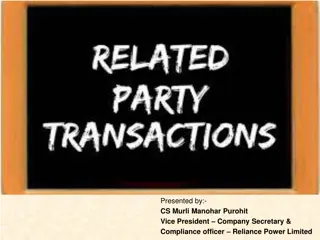Understanding the Rise of Nazi Party Support
The lesson explores why people supported the Nazi Party in Germany during the early 20th century. It examines factors such as the Wall Street Crash of 1929 and the Weimar government's failures, leading to the rise of Adolf Hitler and the Nazi party. Students analyze different interpretations of the events and policies that shaped this period of German history.
Download Presentation

Please find below an Image/Link to download the presentation.
The content on the website is provided AS IS for your information and personal use only. It may not be sold, licensed, or shared on other websites without obtaining consent from the author. Download presentation by click this link. If you encounter any issues during the download, it is possible that the publisher has removed the file from their server.
E N D
Presentation Transcript
Wednesday, 14 August 2024 LESSON TITLE: Why did people support the Nazi Party? 1 2 Annotate around the the table: - What happened to the Nazi vote? - Suggest why might this have happened? (include SFD) Wall street Crash (1929) Massive unemployment in Germany Task 2: What do you notice about the frequency of Reichstag elections over this period? Why might this change? 3 Support
Why did people support the Nazi Party? Mastering To compare differing interpretations on why the Nazi s increased in popularity. Securing To explain how and why the Nazis began to appeal to the German public. Developing To describe the situation of the Nazis in the period 1929- 1933
Background Information Background Information After the Wall Street Crash in 1929 Germany had huge problems. Unemployment reached 6 million by 1933 and even those in work saw their wages fall. People demanded that the Government help solve this problem but they were unable to. The Chancellor, Bruning, recommended higher taxes and reducing unemployment payments as the government simply could not afford them any more. However, this was hugely unpopular with almost everyone and Bruning could not get the Reichstag to agree to these changes. Next Bruning tried to rule by using Article 48. In 1932 there were 66 presidential decrees (where the Chancellor had the President agree to something and make it law without the support of the Reichstag. But even then he could not rule effectively. Bruning resigned in 1932. As the Weimar government became less popular, extremist political parties, such as the Nazis, gained more support. It seemed like they were the only ones who might be able to solve the crisis! 1. 2. What problems did Germany have? How did they attempt to solve these?
There were 5 factors that contributed for the rise in support for the Nazi party: 1.The Depression 2.Response to the Weimar Government 3.Adolf Hitler 4.Fear of other extremist parties 5.Nazi party structure, methods and tactics Read though the 6 interpretations on slide 6 and 7. For each one identify which of the 5 factors are being put forward as the reason for their popularity. For each interpretation, highlight one quote that backs up your idea.
1.The Depression 2.Response to the Weimar Government 3.Adolf Hitler 4.Fear of other extremist parties 5.Nazi party structure, methods and tactics Factor: Adolf Hitler
Interpretations of the Rise of Extremism and the Nazi Party Interpretation A: From a report written by an American diplomat, November 1922. Adolf Hitler has from the first been the dominating force in the Nazi movement, and the personality of this man has been one of the most important factors contributing to its success. His ability to influence an assembly is uncanny. In private conversations he is a forceful and logical speaker, which when tempered with a fanatical earnestness, made a very deep impression on a neutral observer . Interpretation B: From an entry by a German worker in a prize essay contest in 1934 for the best personal life history of a Nazi; this contest was organised by an American researcher trying to find out why people became Nazis. Thousands of factories closed their doors. Hunger was the daily companion of the German working man. Many an honest working man had to resort to theft to obtain food. All fellow citizens yearned for better times. As for me, like many another, I had lost all I possessed, so early in 1930, I joined the Nazi Party Interpretation C: Adapted from an entry in the same 1934 prize essay contest, by a railway worker who was wary of communism. As a railroad worker, I had plenty of opportunity to see the confusion particularly among workers. I saw workers being alienated from the Fatherland. I shuddered at the thought of Germany in the grip of [communism]. At the same time National Socialism, with its promise of a community of blood, barring all class struggle, attracted me profoundly.
Interpretation D: From The World at War: The Landmark Oral History by Richard Homes (2011), in which Konrad Morgan (a student in Germany in the early 1930s) states in an interview in 1973. What did he promise? Work and bread for the masses, for the millions of workers that were unemployed and hungry at that time. Nowadays work and bread doesn t men very much, but at the time it was an absolute necessity a basic need, and this promise that wouldn t make any sense today then it sounded like a promise of paradise. Interpretation E: From the BBC documentary series The Nazis: A Warning from history (1997) In the economic crisis, the Nazis vote increased. They still said the same that Versailles was a crime, Jews should be persecuted, Germany must be reborn. Their message hadn t changed, it was just that now more Germans were ready to hear it. Interpretation F: Adapted from Inside the Third Reich by Albert Speer (1960). Speer was a leading Nazi, and he describes what he felt after hearing a speech by Hitler in 1931. Here it seemed to me was hope. Here were new ideals, a new understanding, new tasks. The perils of communism could be checked, Hitler persuaded us, and instead of hopeless unemployment, Germany could move towards economic recovery. It must have been during those months that my mother saw a Stormtrooper parade in the streets of Heidelberg. The sight of discipline in a time of chaos, the impression of energy in an atmosphere of universal hopelessness, seemed to have won her over.
Study Interpretations 1 and 2. They give different views about why support for the Nazi party increased 1929-33. What is the main difference between these views? Explain your answer, using details from both interpretations. (4 marks) Interpretation 1: by Richard Evans, 2004 Nazi propaganda skilfully targeted specific groups a whole range of posters and leaflets designed to win over different parts of the electorate. Interpretation 1 suggests This is shown by the quote Interpretation 2 suggests This is shown by the quote Interpretation 2: by John Toland, 1976 In 1930 he was offering something new to Germans unity. He welcomed all. There was no class distinction; the only demand was to follow him in his fight against Jews and Reds, in his struggle for Lebensraum and the glory and good of Germany. The difference between the interpretations is Task 2: Suggest a reason why these two interpretations would have different views of the same event.
Create a placard Create a placard to show why to show why people voted for people voted for Hitler and the Hitler and the NSADP NSADP Task 2: Despite knowing how it all ends up, can you understand why the German people turned to the NSADP in 1932?


